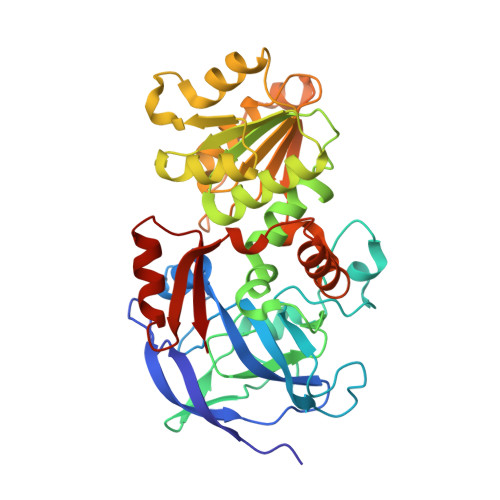Structure-function relationships in human Class III alcohol dehydrogenase (formaldehyde dehydrogenase)
Sanghani, P.C., Robinson, H., Bennett-Lovsey, R., Hurley, T.D., Bosron, W.F.(2003) Chem Biol Interact 143: 195-200
- PubMed: 12604204
- DOI: https://doi.org/10.1016/s0009-2797(02)00203-x
- Primary Citation of Related Structures:
1MP0 - PubMed Abstract:
Human Class III alcohol dehydrogenase (ADH), also known as glutathione-dependent formaldehyde dehydrogenase plays an important role in the formaldehyde detoxification and reduction of the nitric oxide metabolite s-nitrosoglutathione (GSNO). It follows a random bi bi kinetic mechanism and prefers bulkier substrates like long chain primary alcohols and glutathione adducts like s-hydroxymethylglutathione and GSNO over smaller alcohols like ethanol. The structure of the FDH.NAD(H) binary complex reported here, in conjunction with the other complexes of FDH, provide the structural basis of the kinetic observations. These structures show that the apoenzyme has a semi-open domain conformation that permits random random addition of alcohol or NAD(H). Moreover, there is no significant domain movement upon binding of the coenzyme or the substrate, 12-hydroxydodecanoic acid. Interestingly, two active site zinc coordination environments are observed in FDH. In the apoenzyme, the active site zinc is coordinated to Cys44, His66, Cys173 and a water molecule. In the FDH.NAD(H) binary complex reported here, Glu67 is added to the coordination environment of the active site zinc and the distance between the water molecule and zinc is increased. This change in the zinc coordination, brought about by the displacement of zinc of about 2 A towards Glu67 could promote substrate exchange at the active site metal during catalysis.
Organizational Affiliation:
Department of Biochemistry and Molecular Biology, Indiana University School of Medicine, 635 Barnhill Drive Room 4023A, Indianapolis, IN 46202-5122, USA.


















